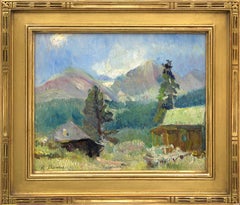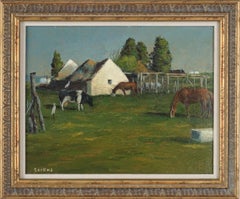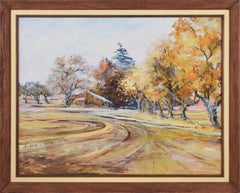Randall Davey Landscape Paintings
Randall Davey was born in East Orange, New Jersey. He attended college at Cornell University, where he briefly studied architecture, but left before completing his bachelor’s degree in favor of a career as a painter. In 1908 he moved to New York, enrolling in classes given by Robert Henri, the influential teacher and leader of the dissident group “The Eight,” which broke with the conservative art establishment in favor of depicting a new realism in art. During the summer of 1910 Davey attended Henri’s classes in Holland; the following summer he accompanied George Bellows and Henri to Monhegan Island, off the coast of Maine; and in 1912, in the position of assistant instructor, Davey joined Henri’s summer classes in Spain.
Davey returned to New York and became principally a portrait and figure painter in a Henri-derived, vigorously painted realist style. He kept close company with New York school artists, such as Henri, Bellows, John Sloan, and Charles Webster Hawthorne, among others. He frequently went on sketching trips with Henri and the artists in his circle, visiting Monhegan, Maine, Gloucester, Massachusetts, and ultimately Santa Fe, New Mexico, where Davey moved permanently with Henri’s encouragement in 1920.
Davey became a leading figure in the vibrant artistic community in Santa Fe. Unusual among the artists there, Davey eschewed the prevailing local taste for the Pueblo Indian cultural aesthetic, instead painting landscapes of the desert in all its seasonal variations. As the lone Henri protégé to settle in Santa Fe, Davey made his home and studio an outpost for his non-resident realist-painter friends who regularly visited the area, including especially his close friend, John Sloan. Davey remained connected to the New York art world, exhibiting frequently at the National Academy of Design and other venues in the city. An early independent artist, Davey was elected an associate member of the National Academy in 1937, and was advanced to full membership the following year.
By the early 1930s, Davey began painting pictures of racehorses, polo matches and racetrack scenes, subjects for which he is best known today. In 1955 he reminisced that he had “always been interested in horses, but I didn’t really start doing horse things until after I saw the Grand National steeplechase in England ... I think in 1930” (transcript, interview of August 31, 1955, archives of the Museum of Fine Arts, Santa Fe, as quoted in Donelson F. Hoopes, “Randall Vernon Davey [1887–1964],” in “Randall Davey: Artist/Bon Vivant, a Retrospective Exhibition 1910–1963,” exhib. cat. [Santa Fe: Museum of Fine Arts, Museum of New Mexico, 1984], n.p.). This recollection is confirmed by a review of a solo exhibition of Davey’s works at the Rehn Galleries, New York, held in March 1930, that largely contained Davey’s new horse racing pictures:
Last season Randall Davey “did” the race tracks of England, and, judging from the sketches he made at the time, and the painting that has developed out of those first impressions, he must have had a grand trip ...
Randall Davey calls himself a realist, and rightly so. Excepting the one or two portraits painted photographically, he gives his audience not so much a graphic description as an understandable impression ...
You find yourself growing a little in aristocratic stature as you watch these animals take their fastidious steps. Few subjects offer, ready-made, a greater chance for color. Davey has not lost the opportunity to play with sullen greens, flavoring them with the bright satin spots found in the coast of the riders (Ruth Green Harris, “In Various Galleries,” New York Times, March 2, 1930, p. 147).
Race Track evinces the vigorous and broadly painted brushstrokes that characterize Davey’s horse racing pictures, as well as the aristocratic air of the race. While pictures such as this recall the George Bellows’s famous polo scenes of the 1910s, Davey’s style and approach are very much his own. His friend John Sloan wrote in 1951:
Randall Davey belongs to a vanishing breed of artist — the man who paints for himself. In his case, this is a particularly admirable characteristic, for with natural facility and great social charm, Davey could have chosen the easy way to success. Some artists are tempted to compromise when the Bitch Goddess beckons, say, in their forties, with a prize and a commission or two — and one understands while not condoning the decision of an artist who has struggled with poverty for twenty years before facing this dilemma.... It takes courage to be an independent (John Sloan, “Randall Davey,” New Mexico Quarterly 21 [Spring 1951], p. 20, as quoted in Hoopes, n.p.).
(Biography provided by Hirschl & Adler)
Mid-20th Century American Impressionist Randall Davey Landscape Paintings
Oil
1950s American Impressionist Randall Davey Landscape Paintings
Oil, Canvas, Illustration Board
1970s American Impressionist Randall Davey Landscape Paintings
Canvas, Oil
Early 20th Century American Impressionist Randall Davey Landscape Paintings
Masonite, Oil, Linen
21st Century and Contemporary American Impressionist Randall Davey Landscape Paintings
Canvas, Oil
1990s American Impressionist Randall Davey Landscape Paintings
Canvas, Oil, Illustration Board
1960s American Impressionist Randall Davey Landscape Paintings
Masonite, Oil
1950s American Impressionist Randall Davey Landscape Paintings
Masonite, Oil
1950s American Impressionist Randall Davey Landscape Paintings
Canvas, Oil
1970s American Impressionist Randall Davey Landscape Paintings
Canvas, Oil
1970s American Impressionist Randall Davey Landscape Paintings
Canvas, Oil
Early 2000s American Impressionist Randall Davey Landscape Paintings
Oil, Fiberboard
Late 20th Century American Impressionist Randall Davey Landscape Paintings
Canvas, Oil


